Bovril boats, also known formally as sludge vessels, [1] were specially designed sewage dumping vessels that operated on the River Thames from 1887 [2] to 1998. Their task was to remove London's human solid waste from Beckton and Crossness for disposal on the ebb tide at sea, at Black Deep, an extremely deep part of the North Sea fifteen miles off Foulness, on one of the main approaches to the Thames Estuary. Similar boats operated on the Manchester Ship Canal, the Tyne, and elsewhere.
The introduction of the flush toilet in the 1840s caused London's ageing sewers to overflow. In 1858 following the summer of The Great Stink and outbreaks of cholera among the public, Sir Joseph Bazalgette was appointed to redesign London's sewage system. [3] [4] [5] He was only partially successful however, as the sludge part of the human waste sewage began to build up on mud banks further down stream along the Thames.
The seriousness of the problem was highlighted in 1878 when a passenger steamer, The Princess Alice, sank at Gallions Reach following a collision with a cargo vessel, with great loss of life including many children. After the dead were later recovered by watermen, it was found that many had in fact not drowned, but instead had died from ingesting the poisoned waters of the toxic sludge-filled river.
A Royal Commission of 1882 concluded that it was necessary to create a cleaner river by separating the sludge part from the liquid sewage and remove it via boat for disposal at sea. In 1887 the first ship of a long line of 'pump and dump' effluent tanker vessels was launched. These ships, later nicknamed by those who crewed them as Bovril boats to describe their brown liquid cargo, were very well maintained, as hygienic as possible, and specially designed for marine disposal. Complex hydrostatic calculations had to be made when carrying liquid cargo but crews received reasonably good pay and regular work. The last of the fleet were: Bexley , Hounslow , and Newham , all named after London Boroughs.
In the 1990s, European Union legislation forbidding the dumping of raw sewage at sea, and increasing environmental concerns that sewage was contaminating beaches, led to the phasing out of the fleet and many were scrapped or sold on to private companies. Newer technology [6] finally allowed the sludge to be incinerated in a self-powering incinerator and sold on as fertilizer pellets for use on food crops.

SS Princess Alice, formerly PS Bute, was a passenger paddle steamer that sank on 3 September 1878 after a collision with the collier Bywell Castle on the River Thames. Between 600 and 700 people died, all from Princess Alice, the greatest loss of life of any British inland waterway shipping accident. No passenger list or headcount was made, so the exact figure of those who died has never been known.

Sir Joseph William Bazalgette CB was a 19th-century English civil engineer. As chief engineer of London's Metropolitan Board of Works, his major achievement was the creation of a sewerage system for central London which was instrumental in relieving the city from cholera epidemics, while beginning to clean the River Thames. He was also the designer of Hammersmith Bridge.

The London sewerage system is part of the water infrastructure serving London, England. The modern system was developed during the late 19th century, and as London has grown the system has been expanded. It is currently owned and operated by Thames Water and serves almost all of Greater London.

A cesspit, is a term with various meanings: it is used to describe either an underground holding tank or a soak pit. It can be used for the temporary collection and storage of feces, excreta or fecal sludge as part of an on-site sanitation system and has some similarities with septic tanks or with soak pits. Traditionally, it was a deep cylindrical chamber dug into the ground, having approximate dimensions of 1 metre diameter and 2–3 metres depth. Their appearance was similar to that of a hand-dug water well.

The Northern Outfall Sewer (NOS) is a major gravity sewer which runs from Wick Lane in Hackney to Beckton sewage treatment works in east London; most of it was designed by Joseph Bazalgette after an outbreak of cholera in 1853 and the "Great Stink" of 1858.

The Southern Outfall Sewer is a major sewer taking sewage from the southern area of central London to Crossness in south-east London. Flows from three interceptory sewers combine at a pumping station in Deptford and then run under Greenwich, Woolwich, Plumstead and across Erith marshes. The Outfall Sewer was designed by Joseph Bazalgette after an outbreak of cholera in 1853 and "The Big Stink" of 1858. Work started on the sewer in 1860 and it was finally opened on 4 April 1865 by H.R.H. the Prince of Wales.

The Great Stink was an event in Central London in July and August 1858 during which the hot weather exacerbated the smell of untreated human waste and industrial effluent that was present on the banks of the River Thames. The problem had been mounting for some years, with an ageing and inadequate sewer system that emptied directly into the Thames. The miasma from the effluent was thought to transmit contagious diseases, and three outbreaks of cholera before the Great Stink were blamed on the ongoing problems with the river.
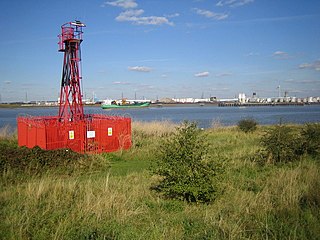
Crossness is a location in the London Borough of Bexley, close to the southern bank of the River Thames, to the east of Thamesmead, west of Belvedere and north-west of Erith. The place takes its name from Cross Ness, a specific promontory on the southern bank of the River Thames. In maritime terms, the tip of Cross Ness, in the past referred to as 'Leather Bottle Point', marks the boundary between Barking Reach and Halfway Reach. An unmanned lighthouse on Crossness is a navigational aid to shipping.
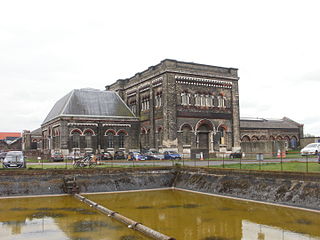
The Crossness Pumping Station is a former sewage pumping station designed by the Metropolitan Board of Works's chief engineer Sir Joseph Bazalgette and architect Charles Henry Driver at the eastern end of the Southern Outfall Sewer and the Ridgeway path in the London Borough of Bexley. Constructed between 1859 and 1865 by William Webster, as part of Bazalgette's redevelopment of the London sewerage system, it features spectacular ornamental cast ironwork, that Nikolaus Pevsner described as "a masterpiece of engineering – a Victorian cathedral of ironwork".
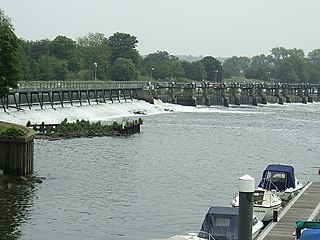
The Tideway is that part of the River Thames in England which is subject to tides. This stretch of water is downstream from Teddington Lock. The Tideway comprises the upper Thames Estuary including the Pool of London.
The utility infrastructure of London, England comprises a range of services and facilities that support and enable the functioning of London as a world city. Infrastructure includes facilities associated with products and materials that are consumed such as electricity, gas, water, heating and liquid fuels; materials that are produced such as sewage and solid waste; and facilities that enable communication and connectivity – telecommunications.
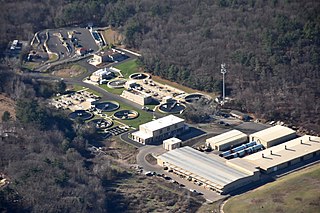
Sewage treatment is a type of wastewater treatment which aims to remove contaminants from sewage to produce an effluent that is suitable for discharge to the surrounding environment or an intended reuse application, thereby preventing water pollution from raw sewage discharges. Sewage contains wastewater from households and businesses and possibly pre-treated industrial wastewater. There is a high number of sewage treatment processes to choose from. These can range from decentralized systems to large centralized systems involving a network of pipes and pump stations which convey the sewage to a treatment plant. For cities that have a combined sewer, the sewers will also carry urban runoff (stormwater) to the sewage treatment plant.
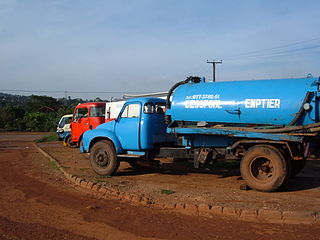
A vacuum truck or vacuum tanker is a tank truck that has a pump and a tank. The pump is designed to pneumatically suck liquids, sludges, slurries, or the like from a location into the tank of the truck. The objective is to enable transport of the liquid material via road to another location. Vacuum trucks transport the collected material to a treatment or disposal site, for example a sewage treatment plant.

Beckton Sewage Treatment Works is a sewage treatment plant in Beckton in the London Borough of Newham, East London. It was formerly known as Barking Sewage Works. It was built from 1864 and, now operated by Thames Water, it is one of the largest sewage works in the United Kingdom. It treats the waste water from the Northern Outfall Sewer serving North and East London. The plant has been extended and upgraded several times, most recently in 2011–13, and now covers over 100 hectares.

The history of water supply and sanitation is one of a logistical challenge to provide clean water and sanitation systems since the dawn of civilization. Where water resources, infrastructure or sanitation systems were insufficient, diseases spread and people fell sick or died prematurely.

Mogden Sewage Treatment Works is a sewage treatment plant in the Ivybridge section of Isleworth, West London, formerly known as Mogden. Built in 1931–36 by Middlesex County Council and now operated by Thames Water, it is the third largest sewage works in the United Kingdom. It treats the waste water from about 1.9 million people served by three sewers in North and West London. The plant has been extended to its geographical boundaries and is constantly being upgraded with new process, most recently in OfWat Amp6 by the Costain Atkins Joint venture who delivered 6MW of Combined Heat and Power (CHP) generation, New process air blowers for Batterys A&B and 6 new gravity sludge thickening streams. The site now covers 55 hectares.
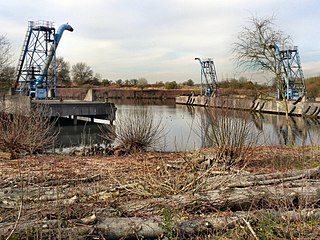
Davyhulme Sewage Works is the main waste water treatment works for the city of Manchester, England, and one of the largest in Europe. It was opened in 1894, and has pioneered the improvement of treatment processes.

MV Gardyloo was a specially designed sewage dumping vessel that operated from Leith between 1978 and 1998. The ship's name is an 18th-century word derived from the French "gardez l’eau", used in Edinburgh to warn passers-by of waste about to be thrown from a window into the street below. Prior to 1978, the city of Edinburgh's waste was discharged into the Forth from a series of eight outlets along the coastline, where it often washed back up on beaches and rocks.

Deptford Pumping Station is a sewage pumping station built in 1865 to the east of Deptford. It is part of the London sewerage system devised by Sir Joseph Bazalgette in the mid 19th century. Today operated by Thames Water, it is located on the western side of Norman Road, approximately 0.5 km (0.31 mi) south west of Greenwich town centre, on the eastern bank of Deptford Creek, around 0.5 km (0.31 mi) south of its confluence with the River Thames.
The Crossness Sewage Treatment Works at Crossness (TQ487805) in the London Borough of Greenwich is located at the eastern end of the Southern Outfall Sewer. It was opened in 1865 and is one of the largest sewage works in the United Kingdom. It treats the waste water from the Southern Outfall Sewer serving South and South East London, and is associated with the adjacent Crossness Pumping Station. It is operated by Thames Water.